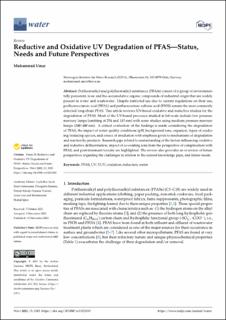| dc.description.abstract | Perfluoroalkyl and polyfluoroalkyl substances (PFASs) consist of a group of environmentally persistent, toxic and bio-accumulative organic compounds of industrial origin that are widely present in water and wastewater. Despite restricted use due to current regulations on their use, perfluorooctanoic acid (PFOA) and perfluorooctane sulfonic acid (PFOS) remain the most commonly detected long-chain PFAS. This article reviews UV-based oxidative and reductive studies for the degradation of PFAS. Most of the UV-based processes studied at lab-scale include low pressure mercury lamps (emitting at 254 and 185 nm) with some studies using medium pressure mercury lamps (200–400 nm). A critical evaluation of the findings is made considering the degradation of PFAS, the impact of water quality conditions (pH, background ions, organics), types of oxidizing/reducing species, and source of irradiation with emphasis given to mechanisms of degradation and reaction by-products. Research gaps related to understanding of the factors influencing oxidative and reductive defluorination, impact of co-existing ions from the perspective of complexation with PFAS, and post-treatment toxicity are highlighted. The review also provides an overview of future perspectives regarding the challenges in relation to the current knowledge gaps, and future needs. | en_US |

